
June is LGBTQ Pride Month, and across the United States, cities, towns, businesses, and schools celebrate with an array of special events. It’s a great opportunity to highlight some wonderful middle grade books featuring LGBTQ characters. All descriptions, images, and links are from Indiebound.
Books Where a Main Character is Lesbian, Gay, Bisexual, or Questioning

The House You Pass on the Way by Jacqueline Woodson
Thirteen-year-old Staggerlee used to be called Evangeline, but she took on a fiercer name. She’s always been different–set apart by the tragic deaths of her grandparents in an anti-civil rights bombing, by her parents’ interracial marriage, and by her family’s retreat from the world. This summer she has a new reason to feel set apart–her confused longing for her friend Hazel. When cousin Trout comes to stay, she gives Staggerlee a first glimpse of her possible future selves and the world beyond childhood.
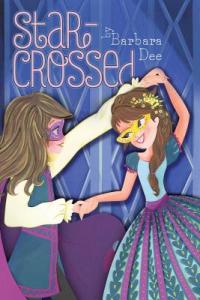
Star-Crossed by Barbara Dee
Mattie is chosen to play Romeo opposite her crush in the eighth grade production of Shakespeare’s most beloved play in this Romeo and Juliet inspired novel from the author of Truth or Dare. Mattie, a star student and passionate reader, is delighted when her English teacher announces the eighth grade will be staging Romeo and Juliet. And she is even more excited when, after a series of events, she finds herself playing Romeo, opposite Gemma Braithwaite’s Juliet. Gemma, the new girl at school, is brilliant, pretty, outgoing–and, if all that wasn’t enough: British. As the cast prepares for opening night, Mattie finds herself growing increasingly attracted to Gemma and confused, since, just days before, she had found herself crushing on a boy named Elijah. Is it possible to have a crush on both boys AND girls? If that wasn’t enough to deal with, things backstage at the production are starting to rival any Shakespearean drama In this sweet and funny look at the complicated nature of middle school romance, Mattie learns how to be the lead player in her own life.

Better Nate than Ever by Tim Federle
Nate Foster has big dreams. His whole life, he’s wanted to star in a Broadway show. (Heck, he’d settle for seeing a Broadway show.) But how is Nate supposed to make his dreams come true when he’s stuck in Jankburg, Pennsylvania, where no one (except his best pal Libby) appreciates a good show tune? With Libby’s help, Nate plans a daring overnight escape to New York. There’s an open casting call for E.T.: The Musical, and Nate knows this could be the difference between small-town blues and big-time stardom.

Five, Six, Seven, Nate by Tim Federle
Armed with a one-way ticket to New York City, small-town theater geek Nate is off to start rehearsals for E.T.: The Broadway Musical. It’s everything he ever practiced his autograph for But as thrilling as Broadway is, rehearsals are nothing like Nate expects: full of intimidating child stars, cut-throat understudies, and a director who can’t even remember Nate’s name.
Now, as the countdown to opening night is starting to feel more like a time bomb, Nate is going to need more than his lucky rabbit’s foot if he ever wants to see his name in lights. He may even need a showbiz miracle.

Letters in the Attic by Bonnie Shimko

Marco Impossible by Hannah Moskowitz
Best friends Stephen and Marco attempt a go-for-broke heist to break into the high school prom and get Marco onstage to confess his love for (and hopefully steal the heart of) Benji, the adorable exchange student and bass player of the prom band. Of course, things don’t always go according to plan, and every heist comes with its fair share of hijinks.

Drama by Raina Telgemeier
Callie loves theater. And while she would totally try out for her middle school’s production of “Moon over Mississippi,” she can’t really sing. Instead she’s the set designer for the drama department’s stage crew, and this year she’s determined to create a set worthy of Broadway on a middle-school budget. But how can she, when she doesn’t know much about carpentry, ticket sales are down, and the crew members are having trouble working together? Not to mention the onstage AND offstage drama that occurs once the actors are chosen. And when two cute brothers enter the picture, things get even crazier.
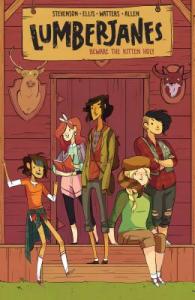
Lumberjanes by Noelle Stephenson and Grace Ellis, illus. by Brooke Allen
Five best friends spending the summer at Lumberjane scout camp…defeating yetis, three-eyed wolves, and giant falcons…what’s not to love? Friendship to the max Jo, April, Mal, Molly and Ripley are five best pals determined to have an awesome summer together…and they’re not gonna let any insane quest or an array of supernatural critters get in their way.

Princess Princess Ever After by Katie O’Neill
When the heroic princess Amira rescues the kind-hearted princess Sadie from her tower prison, neither expects to find a true friend in the bargain. Yet as they adventure across the kingdom, they discover that they bring out the very best in the other person. They’ll need to join forces and use all the know-how, kindness, and bravery they have in order to defeat their greatest foe yet: a jealous sorceress, who wants to get rid of Sadie once and for all. Join Sadie and Amira, two very different princesses with very different strengths, on their journey to figure out what “happily ever after” really means–and how they can find it with each other.

My Most Excellent Year by Steve Kluger
Best friends and unofficial brothers since they were six, ninth-graders T.C. and Augie have got the world figured out. But that all changes when both friends fall in love for the first time. Enter Al. She’s pretty, sassy, and on her way to Harvard. T.C. falls hard, but Al is playing hard to get. Meanwhile, Augie realizes that he’s got a crush on a boy. It’s not so clear to him, but to his family and friends, it’s totally obvious. Told in alternating perspectives, this is the hilarious and touching story of their most excellent year, where these three friends discover love, themselves, and how a little magic and Mary Poppins can go a long way.

So Hard to Say by Alex Sanchez
When Frederick shows up at school, Xio is thrilled. The new boy is shy, cute, and definitely good boyfriend material. Before long, she pulls him into her lively circle of friends. Frederick knows he should be flattered by Xio’s attention. After all, she’s popular, pretty, and a lot of fun. So why can’t he stop thinking about Victor, the captain of the soccer team, instead?

Husky by Justin Sayre
Twelve-year-old Davis lives in an old brownstone with his mother and grandmother in Brooklyn. He loves people-watching in Prospect Park, visiting his mom in the bakery she owns, and listening to the biggest operas he can find as he walks everywhere.
But Davis is having a difficult summer. As questions of sexuality begin to enter his mind, he worries people don’t see him as anything other than “husky.” To make matters worse, his best girlfriends are starting to hang out with mean girls and popular boys. Davis is equally concerned about the distance forming between him and his single mother as she begins dating again, and about his changing relationship with his amusingly loud Irish grandmother, Nanny.
Ultimately, Davis learns to see himself outside of his one defining adjective. He’s a kid with unique interests, admirable qualities, and people who will love him no matter what changes life brings about.

Lily and Dunkin by Donna Gephart
Lily Jo McGrother, born Timothy McGrother, is a girl. But being a girl is not so easy when you look like a boy. Especially when you’re in the eighth grade.
Dunkin Dorfman, birth name Norbert Dorfman, is dealing with bipolar disorder and has just moved from the New Jersey town he’s called home for the past thirteen years. This would be hard enough, but the fact that he is also hiding from a painful secret makes it even worse.
One summer morning, Lily Jo McGrother meets Dunkin Dorfman, and their lives forever change.

George by Alex Gino
When people look at George, they think they see a boy. But she knows she’s not a boy. She knows she’s a girl.
George thinks she’ll have to keep this a secret forever. Then her teacher announces that their class play is going to be Charlotte’s Web. George really, really, REALLY wants to play Charlotte. But the teacher says she can’t even try out for the part . . . because she’s a boy.
With the help of her best friend, Kelly, George comes up with a plan. Not just so she can be Charlotte — but so everyone can know who she is, once and for all.

Gracefully Grayson by Ami Polonsky
Grayson Sender has been holding onto a secret for what seems like forever: “he” is a girl on the inside, stuck in the wrong gender’s body. The weight of this secret is crushing, but sharing it would mean facing ridicule, scorn, rejection, or worse. Despite the risks, Grayson’s true self itches to break free. Will new strength from an unexpected friendship and a caring teacher’s wisdom be enough to help Grayson step into the spotlight she was born to inhabit?
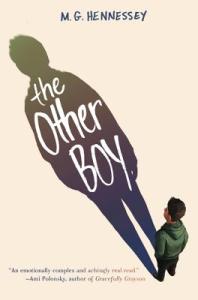
The Other Boy by M.G. Hennessey
Twelve-year-old Shane Woods is just a regular boy. He loves pitching for his baseball team, working on his graphic novel, and hanging out with his best friend, Josh. But Shane is keeping something private, something that might make a difference to his friends and teammates, even Josh. And when a classmate threatens to reveal his secret, Shane’s whole world comes crashing down. It will take a lot of courage for Shane to ignore the hate and show the world that he’s still the same boy he was before. And in the end, those who stand beside him may surprise everyone, including Shane.
Books Where a Main Character has Gay or Lesbian Parents

The Lotterys Plus One by Emma Donoghue
Sumac Lottery is nine years old and the self-proclaimed “good girl” of her (VERY) large, (EXTREMELY) unruly family. And what a family the Lotterys are: four parents, children both adopted and biological, and a menagerie of pets, all living and learning together in a sprawling house called Camelottery. Then one day, the news breaks that one of their grandfathers is suffering from dementia and will be coming to live with them. And not just any grandfather; the long dormant “Grumps,” who fell out with his son so long ago that he hasn’t been part of any of their lives.
Suddenly, everything changes. Sumac has to give up her room to make the newcomer feel at home. She tries to be nice, but prickly Grumps’s clearly disapproves of how the Lotterys live: whole grains, strange vegetables, rescue pets, a multicultural household… He’s worse than just tough to get along with — Grumps has got to go But can Sumac help him find a home where he belongs?

The Misadventures of the Family Fletcher by Dana Alison Levy
The start of the school year is not going as the Fletcher brothers hoped. Each boy finds his plans for success veering off in unexpected and sometimes diastrous directions. And at home, their miserable new neighbor complains about everything. As the year continues, the boys learn the hard and often hilarious lesson that sometimes what you least expect is what you come to care about the most.

The Family Fletcher Takes Rock Island by Dana Alison Levy
The Fletchers are back on Rock Island, home of all their best summer memories. But from the first day they arrive, it’s clear that this year, things have changed. FIRST, a giant fence is blocking their beloved lighthouse. SECOND, they have new neighbors. THIRD, who the heck is the weird artist guy who’s never actually painting? And FOURTH, there’s now an ice cream truck Can the island stay the same even with these crazy transformations? Over the course of the summer, the Fletchers will learn that sometimes, even in a place where time stands still, the wildest, weirdest, and most wonderful surprises await.
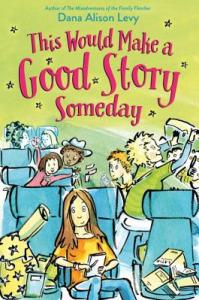
This Would Make a Good Story Someday by Dana Alison Levy
Sara Johnston-Fischer loves her family, of course. But that doesn’t mean she’s thrilled when her summer plans are upended for a surprise cross-country train trip with her two moms, Mimi and Carol; her younger sister, Ladybug; her older sister, Laurel; and Laurel’s poncho-wearing activist boyfriend, Root. And to make matters worse, one of her moms is writing a tell-all book about the trip . . . and that means allllll, every ridiculous and embarrassing moment of Sara’s life. Sara finds herself crisscrossing the country with a gaggle of wild Texans. As they travel from New Orleans to Chicago to the Grand Canyon and beyond, Sara finds herself changing along with the landscape outside the train windows. And she realizes that she just might go home reinvented.

My Mixed-Up Berry Blue Summer by Jennifer Gennari
Twelve-year-old June Farrell is sure of one thing–she’s great at making pies–and she plans to prove it by winning a blue ribbon in the Champlain Valley Fair pie competition. But a backlash against Vermont’s civil union law threatens her family’s security and their business. Even when faced with bullying, June won’t give up on winning the blue ribbon; more importantly, she won’t give up on her family.
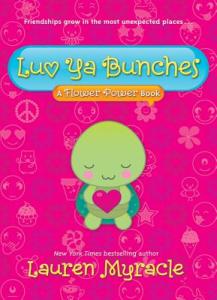
Luv Ya Bunches by Lauren Myracle
What do Katie-Rose, Yasaman, Milla, and Violet have in common? Other than being named after flowers, practically nothing. Katie-Rose is a film director in training. Yasaman is a computer whiz. Milla is third in command of the A list. And Violet is the new girl in school. They’re fab girls, all of them, but they sure aren’t friends. And if evil queen bee Medusa–‘scuse me, Modessa–has her way, they never will be. But this is the beginning of a new school year, when anything can happen and social worlds can collide.

The Popularity Papers by Amy Ignatow
Lydia and Julie are best friends with one goal: to crack the code of popularity. Lydia’s the bold one: aspiring theater star, stick-fighting enthusiast, and human guinea pig. Julie’s the shy one: observer and artist, accidental field hockey jock, and faithful recorder. In this notebook they write down their observations and carry out experiments to try to determine what makes the popular girls tick. But somehow, the harder Lydia and Julie try to imitate the popular girls, the farther they get from their goal and each other.

Double Play by Sara Cassidy
Allie loves baseball. It’s the one thing that has been consistent in her lately complicated life. Allie’s father left recently, and now Allie has a new family — her mother’s new girlfriend, Phyllis, and son Miles have moved in. It’s taking some adjustment, mostly because Miles seems determined to get under her skin. Things start looking up when Allie gets invited to join the boy’s baseball team as their new pitcher. But then Miles announces he’s quitting the boy’s team and tries out for Allie’s old team — a girl’s team
Allie is sure he’s doing it just to annoy her, but Miles insists that he just likes the girl’s style of play better. As Allie struggles to find her place on the boy’s team, she starts to see that Miles is just trying to fit in as well, and that it may be even harder for him than it has been for her.

Best Friend Next Door by Carolyn Mackler
Meet Hannah. Her name is a palindrome. Her birthday is on New Year’s. She wishes she had a cat. She’s medium height and a little awkward. Her life has NOT been fun lately — her dad and stepmom are having a baby and, worst of all, her best friend next door just moved away. Now a new girl is here, taking over her best friend’s bedroom . . . and her own identity.
Meet Emme. Her name is a palindrome. Her birthday is on New Year’s. She loves her enormous orange cat. She’s so short that last week she was mistaken for a kindergartner. She’s found moving hard . . . but at least there’s the girl next door, Hannah. Maybe they’ll become friends?
While Hannah and Emme are alike in so many ways, they’re also different in some wrong ways, too. Is this the perfect friendship . . . or a recipe for disaster?
Katharine Manning has somehow managed to add to her tottering to-be-read pile in putting together this list. She reads, writes, and drinks tea in Washington, D.C. You can find more of her middle grade book recommendations at Kid Book List. She blogs here and at The Winged Pen, and was privileged to serve as a 2016 Cybils judge for poetry and novels in verse. You can find her on Twitter and at www.katharinemanning.com.







 Nicole Porter said, “I would LOVE to see everyone reading Amina’s Voice by Hena Khan this summer! It has universal themes that many middle-grade readers encounter such as shifting friendships, balancing family expectations with personal inclinations, and grappling with self-doubt. Readers will relate to sixth grader Pakistani American Amina’s engagement in these issues as well as see a mirror into their own diverse experiences and the world around them.”
Nicole Porter said, “I would LOVE to see everyone reading Amina’s Voice by Hena Khan this summer! It has universal themes that many middle-grade readers encounter such as shifting friendships, balancing family expectations with personal inclinations, and grappling with self-doubt. Readers will relate to sixth grader Pakistani American Amina’s engagement in these issues as well as see a mirror into their own diverse experiences and the world around them.”
 gs this year. Who doesn’t remember relying on an imaginary friend for comfort and companionship? Crenshaw happens to be a gigantic cat who just may be real in so many ways and only comes when the need is the greatest. My final book is The Poet’s Dog by Patricia MacLachlan, a master storyteller and weaver of words. I haven’t read anything by her in recent years, but picked this up and loved the tale of loss and newfound hope. The dog loses his beloved poet master, but finds two children in need of rescue in a snowstorm. The dog’s musings about his past life, while based on fantasy as the story of an anthropomorphized dog would be, ring so very true to the heart. We can experience loss, but find life in our beloved memories.
gs this year. Who doesn’t remember relying on an imaginary friend for comfort and companionship? Crenshaw happens to be a gigantic cat who just may be real in so many ways and only comes when the need is the greatest. My final book is The Poet’s Dog by Patricia MacLachlan, a master storyteller and weaver of words. I haven’t read anything by her in recent years, but picked this up and loved the tale of loss and newfound hope. The dog loses his beloved poet master, but finds two children in need of rescue in a snowstorm. The dog’s musings about his past life, while based on fantasy as the story of an anthropomorphized dog would be, ring so very true to the heart. We can experience loss, but find life in our beloved memories. to Topaz by Yoshiko Uchida “gives them a very personal look at the internment experience and helps them on the road to becoming world-minded.” Book 3 of Lloyd Alexander’s Chronicles of Prydain is “such a well-written fantasy, with wondering characters, but can be too slow-starting for some kids. Here’s hoping they plow ahead to the terrific rest!” And finally, The Gammage Cup by Carol Kendall is “an oldie but goodie. It’s a fantasy about the tiny Minnipin folk in the Slipper-on-the-Water, a nonconforming few of whom rise up as heroes to defend their village against an invading threat. It offers humor, wonderful characters and true courage and also celebrates independent thinking and a willingness to do the right thing in the face of authoritarian opposition.”
to Topaz by Yoshiko Uchida “gives them a very personal look at the internment experience and helps them on the road to becoming world-minded.” Book 3 of Lloyd Alexander’s Chronicles of Prydain is “such a well-written fantasy, with wondering characters, but can be too slow-starting for some kids. Here’s hoping they plow ahead to the terrific rest!” And finally, The Gammage Cup by Carol Kendall is “an oldie but goodie. It’s a fantasy about the tiny Minnipin folk in the Slipper-on-the-Water, a nonconforming few of whom rise up as heroes to defend their village against an invading threat. It offers humor, wonderful characters and true courage and also celebrates independent thinking and a willingness to do the right thing in the face of authoritarian opposition.” Minamoto Yoshitsune, which “documents the true story of the legendary samurai who was raised in the household of the enemies who killed his father before being sent to live in a monastery where, against the odds, he learned and perfected his fighting skills.” Deborah Ellis’s, The Cat at the Wall, which centers on the Israeli Palestine conflict as told by a talking cat. “A cat sneaks into a small Palestinian house on the West Bank that has been commandeered by two Israeli soldiers. The house seems empty, until the cat realizes that a little boy is hiding beneath the floorboards. Should she help him? After all, she’s just a cat. Or is she? She was once a regular North American girl, but that was before she died and came back to life as a cat.” Caitlin Alifirenka’s, I Will Always Write Back: How One Letter Changed Two Lives, which is the true story of an all-American girl and a boy from Zimbabwe and the letter that changed both of their lives forever. Andrea Davis Pinkney’s, The Red Pencil, which is a Battle of the Books selection. “After her tribal village is attacked by militants, Amira, a young Sudanese girl, must flee to safety at a refugee camp, where she finds hope and the chance to pursue an education in the form of a single red pencil and the friendship and encouragement of a wise elder.” Andrea Gonzales’s Girl Code.
Minamoto Yoshitsune, which “documents the true story of the legendary samurai who was raised in the household of the enemies who killed his father before being sent to live in a monastery where, against the odds, he learned and perfected his fighting skills.” Deborah Ellis’s, The Cat at the Wall, which centers on the Israeli Palestine conflict as told by a talking cat. “A cat sneaks into a small Palestinian house on the West Bank that has been commandeered by two Israeli soldiers. The house seems empty, until the cat realizes that a little boy is hiding beneath the floorboards. Should she help him? After all, she’s just a cat. Or is she? She was once a regular North American girl, but that was before she died and came back to life as a cat.” Caitlin Alifirenka’s, I Will Always Write Back: How One Letter Changed Two Lives, which is the true story of an all-American girl and a boy from Zimbabwe and the letter that changed both of their lives forever. Andrea Davis Pinkney’s, The Red Pencil, which is a Battle of the Books selection. “After her tribal village is attacked by militants, Amira, a young Sudanese girl, must flee to safety at a refugee camp, where she finds hope and the chance to pursue an education in the form of a single red pencil and the friendship and encouragement of a wise elder.” Andrea Gonzales’s Girl Code.  “The teenage phenoms behind viral video game Tampon Run share the story of their experience at Girls Who Code and their rise to fame, plus a savvy look at starts-ups, women in tech, and the power of coding. Dustin Hansen’s Game On! Video Game History, which covers video Game History From Pong and Pac-man to Mario, Minecraft, and More. Jazz Jennings’ Being Jazz. Teen activist and trailblazer Jazz Jennings–named one of The 25 most influential teens of the year by Time–shares her very public transgender journey, as she inspires people to accept the differences in others while they embrace their own truths. And finally, Ashlee Vance’s Elon Musk and the Quest for A Fantastic Future, which is an authorized portrait of one of Silicon Valley’s most dynamic entrepreneurs evaluates his role in the successes of such innovations as Tesla and Space X while evaluating America’s technological competitiveness.”
“The teenage phenoms behind viral video game Tampon Run share the story of their experience at Girls Who Code and their rise to fame, plus a savvy look at starts-ups, women in tech, and the power of coding. Dustin Hansen’s Game On! Video Game History, which covers video Game History From Pong and Pac-man to Mario, Minecraft, and More. Jazz Jennings’ Being Jazz. Teen activist and trailblazer Jazz Jennings–named one of The 25 most influential teens of the year by Time–shares her very public transgender journey, as she inspires people to accept the differences in others while they embrace their own truths. And finally, Ashlee Vance’s Elon Musk and the Quest for A Fantastic Future, which is an authorized portrait of one of Silicon Valley’s most dynamic entrepreneurs evaluates his role in the successes of such innovations as Tesla and Space X while evaluating America’s technological competitiveness.” Man Who Invented the Wild West by Candace Fleming, Isaac the Alchemist: secrets of Isaac Newton, reveal’d by Mary Losure, Elon musk and the quest for a fantastic future: young readers’ edition by Ashley Vance, Women in science: 50 fearless pioneers who changed the world by Rachel Ignotofsky, No better friend: young readers edition: a man, a dog, and their incredible true story of friendship and survival in World War II by Robert Weintraub and The Boy who harnessed the wind by William Kamkwamba.
Man Who Invented the Wild West by Candace Fleming, Isaac the Alchemist: secrets of Isaac Newton, reveal’d by Mary Losure, Elon musk and the quest for a fantastic future: young readers’ edition by Ashley Vance, Women in science: 50 fearless pioneers who changed the world by Rachel Ignotofsky, No better friend: young readers edition: a man, a dog, and their incredible true story of friendship and survival in World War II by Robert Weintraub and The Boy who harnessed the wind by William Kamkwamba. She would also love for kids to pick up “books with unusual structures, to stretch their minds and their concepts of what constitutes a ‘story.’ Unusual structures also help the reader become more involved because they have to have a greater role in assembling and comprehending the story themselves.” She suggests, The
She would also love for kids to pick up “books with unusual structures, to stretch their minds and their concepts of what constitutes a ‘story.’ Unusual structures also help the reader become more involved because they have to have a greater role in assembling and comprehending the story themselves.” She suggests, The  Inquisitor’s tale, one story told in many sometimes contradictory voices by Adam Gidwitz, Booked a novel in verse by Kwame Alexander, Unusual Chickens for the Exceptional Poultry Farmer an epistolary novel by Kelly Jones and the documentary novels, Regarding the… by the Klise sisters.
Inquisitor’s tale, one story told in many sometimes contradictory voices by Adam Gidwitz, Booked a novel in verse by Kwame Alexander, Unusual Chickens for the Exceptional Poultry Farmer an epistolary novel by Kelly Jones and the documentary novels, Regarding the… by the Klise sisters. Moon by Kelly Barnhill, The Glass Sentence and sequels by S.E. Grove, When the Sea Turned to Silver and prequels by Grace Lin, Seraphina by Rachel Hartman, Anything by Robin McKinley or Frances Hardinge, The Naming and sequels by Alison Croggon, Sabriel and sequels by Garth Nix.”
Moon by Kelly Barnhill, The Glass Sentence and sequels by S.E. Grove, When the Sea Turned to Silver and prequels by Grace Lin, Seraphina by Rachel Hartman, Anything by Robin McKinley or Frances Hardinge, The Naming and sequels by Alison Croggon, Sabriel and sequels by Garth Nix.”